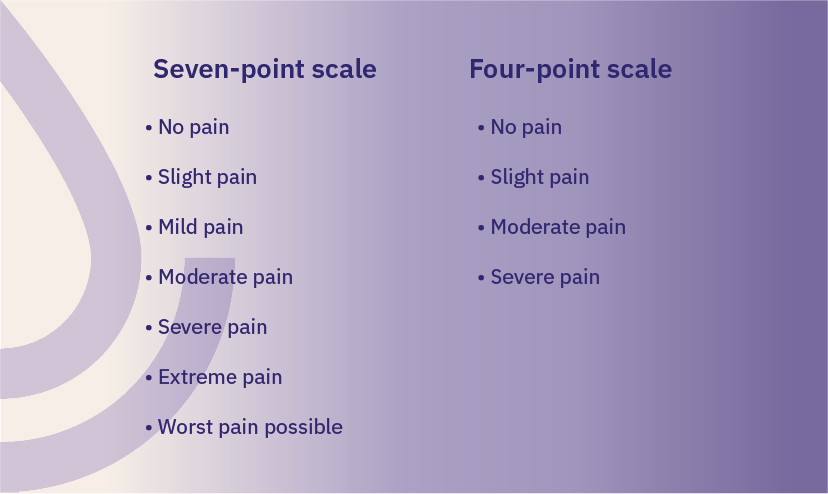Clinicians are often facing time constraints and stressful working conditions. Providing proper pain relief can be time-consuming, as the duration of action can take up a significant portion of the necessary wound treatment. It is important to try to manage the limited time available to offer both pain relief and thorough wound care. One-dimensional pain scales can help you assess the intensity of your patient’s pain, enabling you to quickly make informed decisions about appropriate pain relief measures based on the patient’s needs and the available time frame.
To assess perceived pain and facilitate communication between you as a healthcare professional and your patient, different pain assessment tools are used. These tools should be easy for you and your patients to use and understand. Consistent use of pain assessment tools allows you, as a nurse, to track the progression of pain over time and to take effective pain relief measures.
Please provide your details and we will send you a download link to your e-mail.
Several different pain scales can be used as tools to estimate and assess a patient’s perceived pain. The three most common one-dimensional methods are the numerical scale (NRS), the verbal descriptor scale (VDS/VRS), and the visual analog scale (VAS). These pain scales can provide you with a clear understanding of the patient’s perceived pain level and the ability to adapt treatment accordingly. All of these scales can be relevant, and the choice of scale is tailored to the patient’s needs. However, assessing more complex pain conditions requires more sophisticated measurement instruments that assess pain across multiple dimensions: physical, psychological, social, emotional, and existential.
The numerical scale is a commonly used pain assessment method. It involves asking the patient to indicate their perceived pain on a scale from 0 to 10, where 0 represents no pain and 10 represents the worst possible pain. The patient selects the number that best describes their pain level.

With the visual analog scale, the patient marks a point on a line to indicate the perceived pain intensity. The line ranges from “no pain” to “worst imaginable pain.” By measuring the distance from the starting point to the marker, a visual representation of the pain is obtained, allowing you as a nurse to assess and document the pain intensity.

The verbal descriptor scale or verbal rating scale is another commonly used pain assessment method. This scale prompts the patient to use words to describe the pain intensity. The scale can range from a simple scale with few points (no pain, mild pain, moderate pain, severe pain) to a more detailed scale with more word choices to describe different degrees of pain. The patient selects the word that best describes their pain level. By using a verbal descriptor scale, you get a relatively nuanced understanding of the pain, helping you to understand the patient’s experience in more depth. Verbal descriptor scales can be useful when patients have difficulty using numerical scales.


Our “Complete Guide to leg ulcers” focuses primarily on hard-to-heal venous leg ulcers.
Get guiding about treatment measures, healing phases, cleaning, and appropriate dressings, which can affect and drive the long-term healing process.
https://www.vardhandboken.se/vard-och-behandling/akut-bedomning-och-skattning/smartskattning-av-akut-och-postoperativ-smarta/smartskattningsinstrument/ (Hämtad 2023-05-15)
Lindholm C. Sår. Uppl 4:2 Studentlitteratur AB, 2018